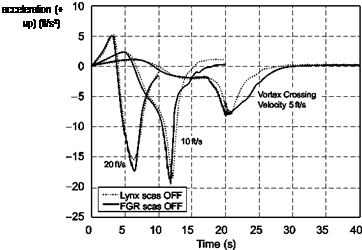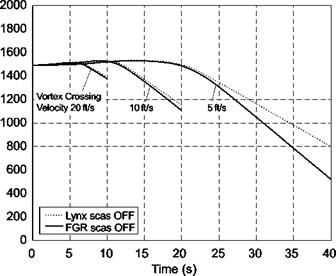Analysis of encounters – vertical response
The vertical motions of the rotorcraft during the vortex encounters are illustrated in Fig. 8.58 (height), Fig. 8.59 (height rate) and Fig. 8.60 (vertical acceleration). The effects of SCAS are negligible in most cases; hence only SCAS-off results are presented. An exception is the vertical acceleration response of the Lynx, which has a feedback loop from acceleration to collective to improve high-speed stability characteristics.
|
|||||
|
|||||
|
|||||
|
|||||
|
|
|
|
Fig. 8.58 Height response in encounter |
The acceleration peaks in Fig. 8.60 would be reduced by 20% with SCAS engaged on the Lynx.
An important point to take into account when interpreting these data is that the initial trim of both aircraft is 100 ft to port of the clockwise-rotating vortex. The collective pitch is therefore lower than the hover value by an amount depending on the rotorspeed and rotor solidity. The fixed collective setting then results in a descent rate in
|
Fig. 8.59 Height rate response in encounter |
 |
the receding vortex tail, which is higher than that corresponding to the hover collective setting. For the Lynx, the reference rate of descent (i. e., the descent rate corresponding to the decreased collective at the initial condition) is about 900 ft/min and for the FGR about 1200 ft/min.
Approaching the vortex core the rotorcraft are lifted up to a maximum rate of climb of about 500 ft/min, followed by a reversal to a rapid descent rate of more than 2500 ft/min (more than 1500 ft/min relative to reference rate of descent noted in the previous paragraph). The slower the encounter, the greater time is spent in the vortex wakes and the larger height loss. At 20 ft/s encounter, 100 ft is lost in about 3 s; at 10 ft/s, 100 ft in 5 s; at 5 ft/s, 100 ft in about 8 s. The lower disc loading on the FGR results in larger peak accelerations and higher descent rates; at the fastest encounter of 20 ft/s, a bump of about -0.5 g is experienced within 3 s of a small positive bump. The descent rates induced in the vortex tail (1100 ft/min – Lynx; 2000 ft/min – FGR, again, relative to reference) are significantly higher than the 650 ft/min minimum requirement for Level 1 performance defined in ADS-33. This suggests that thrust margins of 10-15% would be required to enable a pilot to completely counteract the effects of a vortex encounter.
Handling qualities criteria provide a natural framework within which to set performance margins and quantify severity during upsets caused by vortex encounters. The preceding analysis has demonstrated that an aircraft satisfying minimum Level 1 (tracking) attitude quickness and (aggressive manoeuvring) control power performance should have sufficient control margin to overcome the effects of a full-strength vortex. Satisfying the normal minimum performance requirements for general MTEs will not provide an adequate margin, however. A rate SCAS significantly reduces the disturbance, while the addition of the attitude hold function (Lynx) returns the aircraft to the hover attitude, further reducing the upset. In terms of vertical performance, the minimum Level 1 standard, when translated into a margin for climb performance, is insufficient by a significant margin to overcome the effects of the downwash in the vortex tail.
Table 8.11 Transient pitch attitudes following the vortex encounter
|
Encounter velocity 5ft/s 10ft/s 20ft/s Aircraft Pitch attitude in 3 s (deg) ADS-33 Level 3
|
The performance criteria indicate what is ultimately achievable, but further insight can be gained by comparing the severity of the disturbance against the ADS-33 criteria for the transient response following failures.













